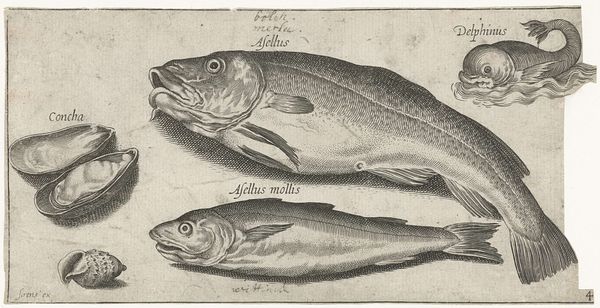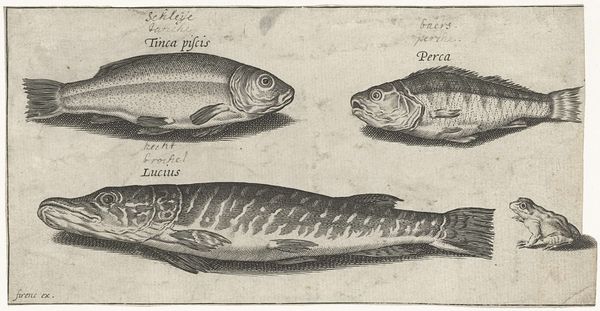
print, engraving
# print
#
history-painting
#
engraving
#
realism
Dimensions: height 93 mm, width 184 mm
Copyright: Rijks Museum: Open Domain
Curator: Pierre Firens' print, dating from 1600 to 1638, titled "Baars, barbeel, brasum en een tandkarper," showcases an array of fish species through the art of engraving. It's quite the catalogue. Editor: It’s remarkable. So austere and precise. What’s striking is the level of detail achieved solely through line work, with such limited tonal variation; it highlights a mastery of engraving techniques. Curator: Absolutely, the engraving brings to mind early scientific illustration. Consider the way Firens used lines to meticulously render each scale and fin. But do you see how the fish, though meticulously rendered, lack a sense of dynamic, lively movement? It points to the constraints placed upon art by the scientific goals it was serving. Editor: I agree. Its public role as a tool for observation, classification, and distribution of knowledge also limits any overt creative flourishes. In effect, it is more in the service of institutions—specifically of expanding the knowledge of natural sciences. But isn't it also celebrating the mastery of craft involved in producing accurate images through this mechanical medium? Curator: I find that thought really intriguing. While ostensibly a record of species, these images, carefully etched and printed, do become commodities within a burgeoning market for natural history prints. Were they sold individually or perhaps bound in volumes? Editor: More research is certainly needed to fully contextualize the production, distribution, and audience reception of this kind of print. But for now, I leave with a deeper appreciation for how images both participate in and shape history. Curator: It's fascinating how closely he worked with those limits, to record not just likeness but a cultural moment.
Comments
No comments
Be the first to comment and join the conversation on the ultimate creative platform.













